QUINACRINE DIHYDROCHLORIDE
- русский язык имя
- английское имяQUINACRINE DIHYDROCHLORIDE
- CAS №69-05-6
- CBNumberCB8320579
- ФормулаC23H32Cl3N3O
- мольный вес472.88
- EINECS200-700-8
- номер MDLMFCD00012659
- файл Mol69-05-6.mol
химическое свойство
| Температура плавления | 249-251℃ (Decomposition) |
| плотность | 1.2962 (rough estimate) |
| показатель преломления | 1.6300 (estimate) |
| температура хранения | +15C to +30C |
| растворимость | DMSO (Slightly), Methanol (Slightly, Sonicated), Water (Slightly) |
| пка | pKa -6.3(H2O t undefined I not reported but low) (Uncertain) |
| форма | Yellow solid |
| цвет | Light Yellow to Yellow |
| РН | 3.0~5.0 (20g/l, 25℃) |
| Биологические источники | synthetic |
| Растворимость в воде | Water: 33.33 mg/mL (70.48 mM) |
| Мерк | 14,8044 |
| БРН | 4834013 |
| Стабильность | Stable. Incompatible with strong oxidizing agents. |
| FDA UNII | 81A613ZZ6X |
| Словарь наркотиков NCI | quinacrine dihydrochloride |
| Код УВД | P01AX05 |
| Система регистрации веществ EPA | Quinacrine hydrochloride (69-05-6) |
| UNSPSC Code | 12352101 |
| NACRES | NA.77 |
больше
| Коды опасности | Xn |
| Заявления о рисках | 22-36/37/38 |
| Заявления о безопасности | 36/37/39 |
| WGK Германия | 3 |
| RTECS | AR7875000 |
| Токсичность | LD50 oral in rabbit: 433mg/kg |
рисовальное письмо(GHS)
-
рисовальное письмо(GHS)

-
сигнальный язык
предупреждение
-
вредная бумага
H302:Вредно при проглатывании.
-
оператор предупредительных мер
P264:После работы тщательно вымыть кожу.
P270:При использовании продукции не курить, не пить, не принимать пищу.
P301+P312:ПРИ ПРОГЛАТЫВАНИИ: Обратиться за медицинской помощью при плохом самочувствии.
P501:Удалить содержимое/ контейнер на утвержденных станциях утилизации отходов.
QUINACRINE DIHYDROCHLORIDE химические свойства, назначение, производство
Химические свойства
yellow crystals or powderИспользование
Quinacrine dihydrochloride has been used:- in its uptake and accumulation studies in mouse lung slices using fluorescence microscope
- in the staining of ATP vesicles in mesenchymal stem cells (MSCs)
- in uptake-release assay for characterization of dense granule functionality of platelets
Показания
Quinacrine is no longer used extensively as an antimalarial drug and has been largely replaced by the 4- aminoquinolines.Антимикробная активность
Mepacrine is active against the asexual erythrocytic stage of all four Plasmodium spp. that infect humans and the gametocytes of P. vivax and P. malariae. The enantiomers have equal antimalarial activity. It exhibits broad activity in experimental models against T. cruzi, Leishmania spp., E. histolytica, Trichomonas vaginalis, G. lamblia and Blastocystis hominis. It is also active against tapeworms.Приобретенная устойчивость
The structural resemblance to chloroquine suggests the likelihood of cross-resistance with that drug, but evidence for this is equivocal.Общее описание
Bright yellowish needles or bright yellow powder. Odorless. pH of a 1% aqueous solution is about 4.5.. Used as an anti-malarial drug. Moderately toxic.Реакции воздуха и воды
Water soluble.Профиль реактивности
QUINACRINE DIHYDROCHLORIDE is an acidic salt of an amine. React as a weak acid to neutralize bases.Пожароопасность
Flash point data for QUINACRINE DIHYDROCHLORIDE are not available, but QUINACRINE DIHYDROCHLORIDE is probably combustible.Фармацевтические приложения
A synthetic acridine derivative, formulated as the hydrochloride for oral use.Фармакокине?тика
Oral absorption: GoodCmax 100 mg oral: 50 μg/L after 1–3 h
Plasma half-life: 5 days
Plasma protein binding: 85%
There is extensive tissue binding and a six-fold concentration into leukocytes from plasma. About 10% of the daily dose is excreted in the urine. It is widely distributed throughout the body.
Клиническое использование
GiardiasisProphylaxis of malaria
Tapeworm infections
Побочные эффекты
Dizziness, headache and gastric problems are common. Toxic psychoses, bone marrow depression, yellow skin and exfoliative dermatitis are described. Poor toleration is noted, especially in children. It should not be used in combination with 8-aminoquinolines.Методы очистки
It crystallises from H2O (solubility is 2.8% at room temperature) as yellow crystals. It is slightly soluble in MeOH and EtOH. The free base crystallises from Me2CO or pet ether with m 86-88o, or aqueous EtOH with 85-87.5o. The bismethiodide has m 224o (from MeOH/EtOAc/Et3N), and the picrate has m 207-208o(dec) when crystallised from Me2CO/EtOH. It is an antimalarial, antiprotozoal and intercalates DNA. [Wolfe Antibiot 3 (Springer-Verlag) 203 1975, Beilstein 22 III/IV 6247, 22/12 V 235.]QUINACRINE DIHYDROCHLORIDE поставщик
| поставщик | телефон | страна | номенклатура продукции | благоприятные условия |
|---|---|---|---|---|
| +86-75521030354 +86-18688942810 |
China | 802 | 55 | |
| +86-0371-86658258 +8613203830695 |
China | 29871 | 58 | |
| +86-023-6139-8061 +86-86-13650506873 |
China | 39894 | 58 | |
| +1-781-999-5354 +1-00000000000 |
United States | 32161 | 58 | |
| +86-0551-65418671 +8618949823763 |
China | 34563 | 58 | |
| +86-27-87465837 +8618971612321 |
China | 9639 | 58 | |
| 571-88938639 +8617705817739 |
China | 52849 | 58 | |
| +1-708-310-1919 +1-13798911105 |
United States | 6391 | 58 | |
| +86-25-58227606 +86-15305155328 |
China | 4128 | 58 | |
| United States | 38631 | 58 |